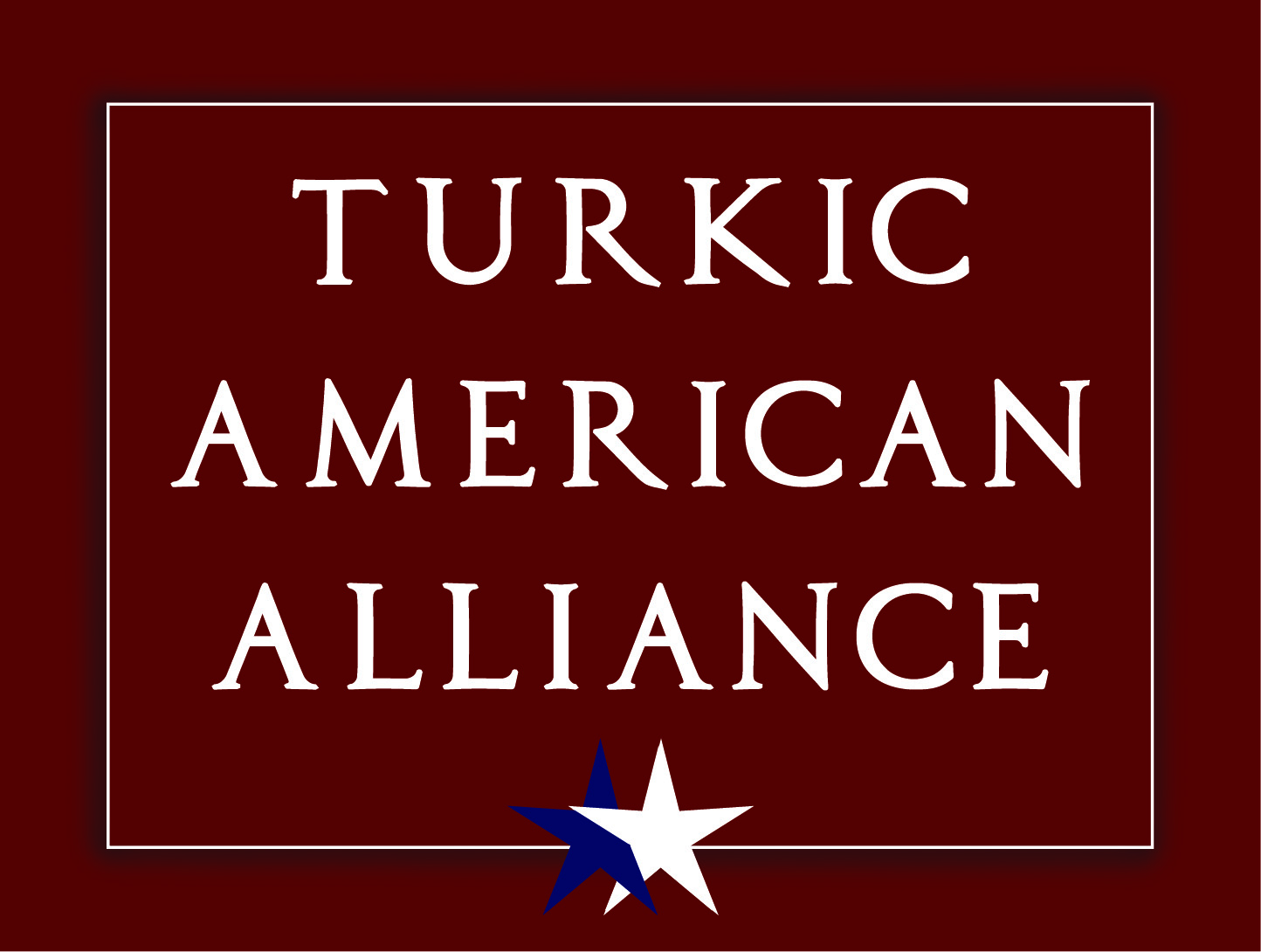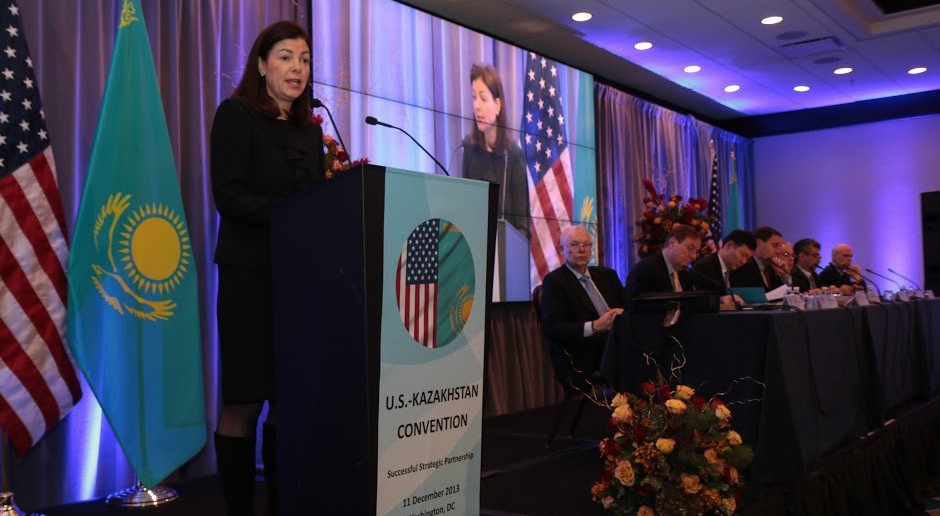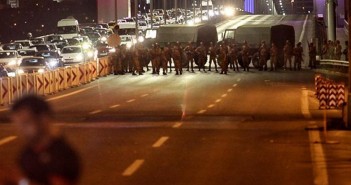Session I of the U.S.-Kazakhstan Convention centered on the theme of “United States-Kazakhstan: Strategic Partnership.”
The session moderator was James F. Collins, Carnegie Endowment Director for Russia and Eurasia.
Introductory remarks were provided by U.S. Senator Kelly Ayotte of New Hampshire. Senator Ayotte discussed how the U.S. was the first country to recognize Kazakhstan as an independent nation in 1991. The Senator went on to describe the 1994 bilateral investment treaty between the U.S. and Kazakhstan as the first step to increased facilitation of trade and investment. Since then, Kazakhstan has played key roles in advancing security in the region by preventing terrorism, engaging in peacekeeping and participating in the Steppe Eagle joint exercises between the U.S., Kazakhstan and the UN. Kazakhstan has also played a critical role in the Northern Distribution Network; in financing a $50 million program to educate Afghan students in Kazakhstan; and through its outstanding commitment to nuclear nonproliferation. In the field of nuclear nonproliferation, Kazakhstan has divested its Soviet-era nuclear warheads and highly enriched uranium, it has become a member to international nonproliferation treaties, and it has hosted two rounds of P5+1 negations in 2013 over Iran’s nuclear program. Nonetheless, Kazakhstan and the greater Eurasian region must employ greater economic integration, empowerment and freedom for women in the long-run.
His Excellency the Ambassador of Kazakhstan next delivered brief remarks before Session I was underway. Ambassador Umarov described Kazakhstan as cherishing its friendship and relationship with the U.S., particularly for helping Kazakhstan to strengthen its democracy during its early years of independence. Ambassador Umarov turned his attention to the U.S.-Kazakhstan strategic partnership for the future, which includes initiatives such as nuclear nonproliferation with greater regional cooperation in Europe and Central Asia, the Northern Distribution Network, and the New Silk Road initiatives to help Kazakhstan beyond 2014. Additionally, as the U.S. economic and diplomatic presence grows in the region, so is Kazakhstan ready to assist its colleagues in working towards the stability of the region. According to the Ambassador, Kazakhstan already maintains high standards of living, stability, and peaceful religious and ethnic coexistence within its borders.
Ambassador Umarov continued to enumerate Kazakhstan’s impressive political portfolio: chair of the Organisation of Islamic Cooperation, the second largest inter-governmental organization in the world; host to the Shanghai Cooperation Organisation (SCO); and chair of the Organisation for the Security and Cooperation of Europe (OSCE). The Ambassador also discussed Kazakhstan’s Strategy 2050, which he described as a visionary and long-term vision to make Kazakhstan one of most developed nations in world by 2050. Such a vision require that U.S. companies, think thanks and NGOs play an important role to help improve Kazakhstan’s private sector efficiency, formulate outside-the-box solutions and in helping to implement projects to protect the environment and build civil society. President Nursultan Nazarbayev has played a seminal role in this process. President Nazarbayev has championed since the country’s independence initiatives for modernization, economic diversification and raising standards of living for all. These initiatives are not only good for Kazakhs, but for neighboring countries, the greater region, and even the world to ensure a prosperous society, however broadly defined, for the long-term. The United States and Kazakhstan maintain a strong common interest in fostering a platform of stability, progress and prosperity throughout the region.
The first speaker for Session I was Richard Hoagland, Principal Deputy Assistant Secretary of State for South and Central Asia at the U.S. State Department and former U.S. Ambassador to Kazakhstan. Ambassador Hoagland described Kazakhstan as an increasingly significant partner in many areas: it has passed fundamental economic reforms; it has given up its nuclear arsenal, the fourth largest in world; and it has given high priority to educate a new generation of Kazakh youth.
In terms of economic reform, Kazakhstan is becoming a highly desirable link along the New Silk Road initiative. Such an initiative will enable a more speedy movement of goods by land in just 15 days, as opposed to the 40 days it currently takes by sea from a factory in China to a rural community in Germany, for instance. Kazakhstan also maintains the highest per capita foreign investment among members of the Commonwealth of Independent States and it is in the process of accession to the World Trade Organization. It still has work to do, however, in terms of intellectual property rights and even applications of laws and regulations.
Kazakhstan also plays a crucial role in global nuclear policy. During 1989-1991, an anti-nuclear movement swept across what is now modern-day Kazakhstan, eventually leading to the closure of the Semipalatinsk Testing Site, which is reported to have caused radiation poisoning and anomalously high rates of birth defects and cancer in thousands of residents within the site’s surrounding region. The movement was called “Nevada Semipalatinsk” to show solidarity with American counterparts at the Nevada Testing Site. According to Ambassador Hoagland, Ambassador Umarov himself played a large role in the process of finally closing the Semipalatinsk Testing Site and in the relinquishing of Kazakhstan’s nuclear arsenal, which was the fourth largest at the time, in the years following its independence. In 2010, with the assistance of Russia, Ukraine and the UK, Kazakhstan transported its highly enriched uranium and plutonium to a secure long-term storage facility to ensure that fissile material could never fall into wrong hands. Recently, in 2013, Kazakhstan twice hosted P5+1 talks regarding Iran’s nuclear capabilities.
In terms of the education of its youth, Kazakhstan under the direction of President Nazarbayev enacted the Bolashak program in 2005, which sponsors 3,000 Kazakh students who are proven leaders in the public and private sectors to study abroad around the world and engage in critical thinking and high-level instruction for success in a knowledge-based economy. Kazakh students are enrolled in universities in the U.S. such as at the University of Pennsylvania, Duke University and the University of Wisconsin. Kazakhstan is also working to change its legacy of patronage to a merit-based senior executive service work force, which will help in the long run to foster democracy and good governance.
According to David Sedney, former Deputy Assistant Secretary of Defense for Afghanistan, Pakistan and Central Asia, Kazakhstan plays a central role in securing a peaceful, secure and stable Central Asia. And what is perhaps so interesting is that Kazakhstan was never pegged or readied to play such a central role; it emerged as a leader all on its own. Nevertheless, Kazakhstan still has a ways to go in terms of its economic and security status quo. This is no easy feat, either, according to what Sidney describes as the “tectonic plates of geopolitics” in Central Asia and its surrounding regions. One quickly thinks of the unique and complex challenges facing Ukraine and Afghanistan today. Indeed, Kiev is demonstrating against the very Customs Union of which Kazakhstan is already a member, which leads to burgeoning questions of where and with whom Kazakhstan’s various interests are aligned and how to best balance them. It also speaks to the values that Kazakhstan holds most important. While Afghanistan’s main interest is to build an army to ensure a monopoly of violence in the country through legitimate means, Kazakhstan’s key interest is governance—how to best exercise the will of the people. Such governance, according to Sidney, is what makes a country, not an army and police forces. In fact, governance and leadership in Kazakhstan has already improved Kazakhstan’s democratic standing, both internally and externally, despite the enormous challenges it has faced. Nonetheless, it is likely that these challenges will become greater in the future, especially in relation to regional powerhouse like China, Russia and even India.
The next speaker was Frederick Kempe, President and CEO of the Atlantic Council. Kempe described today’s world as in an era of global competition, with Kazakhstan’s neighborhood being a particularly challenging one. Kempe described Kazakhstan as a priority in and of itself, as a “pivotal state” in a similar way as is Ukraine and Turkey. Eurasia, too, has outsized its region, leading to what Kempe calls an “historic inflection” for the region. Will Kazakhstan be part of a Russian or Chinese sphere of influence? Or will it become its own independent actor? If it aspires for the latter, Kazakhstan and the Central Asian region as a whole will need to diversity its economies beyond its oil and gas sectors and will need to trade more with other Central Asian republics and other countries. In fact, Central Asian republics trade with one another as much as 5 states located on separate continents would—the lowest trade from among any comparable region in the world. There are simply too many regulatory and other non-tariff barriers to trade.
According to Kempe, some form of regionalism is desperately needed. Another suggestion would be for Kazakhstan to encourage its remaining three Central Asian republics to accede to the WTO so that all of its trade regulations are uniform and compatible. How else will Kazakhstan be able to transform itself from being landlocked to landlinked? The New Silk Road Initiative would certainly be a good place to start, which proposes a transformation of Central Asia as bridge, or roundabout, to connect Far East South Asia with Europe via land routes that are cheaper, safer and more secure than current routes. Kempe also emphasized Kazakhstan’s critical leadership role in developing pan-Eurasian trade and policy infrastructure and architecture with the help of international institutions like the European Bank for Reconstruction and Development and the World Bank. The Trans-Atlantic communities will also support Kazakhstan, which today already receives half of its FDI from the European Union.
Other highlights noted by Kempe are its ethnically mixed population that has largely avoided inter-ethnic strife; its higher education and training initiatives like the Bolashak program; and its construction for new infrastructure in the hydro-carbon industry to connect East to West vis-à-vis Russia and the Black Sea. Kazakhstan has also built strong security relationships, especially through its relinquishing of inherited nuclear weapons, entering into a partnership for peace with NATO, and its membership to the Shanghai Cooperation Organisation. Through a continuation and strengthening of such initiatives, Kazakhstan can become a hub and fulcrum and even an exporter of security and prosperity, particularly for Afghanistan post-2014.
Nonetheless, areas for improvement still remain in Kazakhstan: Foreign Minister Erlan Idrisov must reduce Kazakhstan’s dependence on energy and move instead towards high-tech innovations that allows for increased private enterprise; Kazakhstan must finish its WTO negotiations in order to unlock its trading capabilities; and it must enact stronger regulatory tax and legal procedures, a healthier rule of law and allow more space for private business and less for obstructive state bureaucracy policies.
Ariel Cohen, Senior Research Fellow for Russia and Eurasian Studies and International Energy Policy at the Heritage Foundation, next discussed Kazakhstan’s energy partnerships and green development. Dr. Cohen began by comparing Kazakhstan’s security and geopolitics as the heart and body of its partnerships, while economics, particular energy production, its blood circulation. Kazakhstan is home to some of the largest oil reserves. The peak of Soviet production maintained outputs of 500,000 barrels a day, while today it maintains an astonishing threefold increase at 1.6 million barrels a day. Additionally, 2013 marks the 10th meeting of the U.S.-Kazakh energy partnership, a partnership that includes not just oil, gas, technology and the hydro-carbon sector, but also nuclear security, renewable energies, energy efficiency and electric power.
Kazakhstan also enjoys, as other distinguished speakers have addressed, a strong leadership in the nuclear nonproliferation community. Since its independence, Kazakhstan has enacted programs to halt nuclear proliferation and to enhance international safeguards; has built a nuclear training center; has modernized its nuclear reactors; and has switched its research reactor from high- to low-enriched uranium. President Nazarbayev has also been outspoken in calling for Iran to halt its nuclear enrichment through diplomatic means. Additionally, Kazakhstan has curbed its methane emissions, has lessened its greenhouse gases, has utilized cleaner burning of coal and has developed shale gas.
In addition to its nuclear nonproliferation leadership, Kazakhstan also seeks to become a leader in the world in terms of development. By 2025-2030, Kazakhstan seeks to be among the higher band of median-income countries and maintain a strong tech-economy. The Republic also seeks to switch its Soviet-era coal-burning technologies to greener, more sustainable technologies, such as clean coal, natural gas, hydro, renewables, wind and solar. Kazakhstan has been investing billions to acquire these new technologies, but Dr. Cohen cautioned that it is important not to go overboard. Instead, Dr. Cohen suggested a more gradual acquisition of technologies in order to comprehensively train personnel and adjust its regulatory framework in order that its industries transition to clear, more sustainable policies. Such policies will successfully come about through the coordination of managed researched by the government, state companies and private sector. Through these goals, Kazakhstan has already proven itself a pioneer in Eurasia for transitioning to cleaner energy policies, as well as for moving up the so-called value chain from mining uranium to manufacturing uranium fuel for reactors and in improving and making more efficient its gas network connecting production areas of the country to consumption areas. To conclude, Dr. Cohen mentioned China as an important neighbor for Kazakhstan and a great opportunity for Kazakhstan’s energy sector.
Session I’s final panelist was Sandy Merber, Executive Counsel of the General Electric Company. Merber shared GE’s success story of economic diversification in Kazakhstan. To begin, Merber listed the potential of Kazakhstan’s many natural resources: metals like Chromium, Copper, Magnesium, Lead and Zinc, and its plentiful oil and natural gas reserves. To address these industry and infrastructure needs, GE is planning to build a major railway network (14,400 km) across Kazakhstan through local means of production. GE has already built a state-of-the-art, diesel locomotive assembly facility in 2009 with capabilities of assembling between 100-150 units a year for use in Kazakhstan and for export. The plant employs 700 employees and maintains a 70% localized production supply chain. Employees also include graduates and interns of the Bolashak program.
In addition to building new locomotives, GE also helps to modernize Kazakhstan’s existing fleets. GE is so optimistic about its transportation programs in Kazakhstan that Merber lauded Kazakhstan as the “brightest spot in the world for GE transportation.” GE will also provide infrastructure aid in helping Kazakhstan to realize its 2050 development goals and will assist in construction, modernization, and production high-tech materials. According to Merber, Kazakhstan is an attractive place for GE to be as a result of its large and growing GDP, its plentiful natural resources, its stable political situation and GE’s confidence in the Kazakh government. Kazakhstan is also an attractive entry point for the rest of the region, especially in its membership to the Commonwealth of Independent States and the Customs Union.
General Electric will also be working in other areas beyond Kazakhstan’s transportation industry. GE will assist Kazakhstan in other infrastructure building projects, in power generation, in oil, gas and other energies production, in healthcare and in water purification. With regards to energies production, GE currently operates in oil and gas fields in Kashagan, Tengiz, Zhanazhol, Karachaganak, the Orenburg Pipeline and the Asia Gas Pipeline (AGP). To close, Merber described Kazakhstan’s numerous accomplishments and achievements as not only a success story for Kazakhstan, but a success story for GE as well.
During the Q/A component of Session I, questions were raised about the future of a post-Nazarbayev Kazakhstan. Panelists acknowledged that there is room for Kazakhstan to be a more transparent and open society, and that such changes must derive from the Kazakh people and must not be pressured by external drivers. Nonetheless, panelists responded by emphasizing that is important for the U.S. to remain a long-term partner of Kazakhstan.




